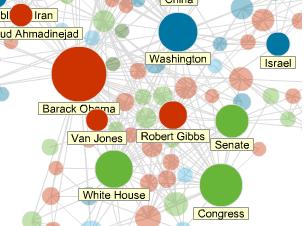 Slate added a curious addition to its site last week. Its heart is in the right place, and this is a good experiment, not a silly one.
Slate added a curious addition to its site last week. Its heart is in the right place, and this is a good experiment, not a silly one.
I believe there’s extraordinary value to be unlocked by mapping a world of articles onto the social graph that they describe textually. I’ve written about graphing the news when I awkwardly described a scheme here and geeked out over a pretty picture here. Yes, there is a funny thing about social networks: they often describe the real world as well as sometimes exist as their own worlds. Done right, Slate’s graph could be an eye-opening mechanism for aggregating, sorting, discovering, following, sharing, and discussing the news.
But I don’t think Slate has quite done it right. In short, there’s too much information in the nodes, or the “dots,” as Slate calls them, and there’s too little information in the edges, or the links that connect up those dots. So permit me a little rambling.
We don’t really care all that much about the differences between a person, a group, and company—not at this top level of navigation, anyhow. There are too many dots, and it’s too hard to keep them all the colors straight. Of course, it’s not that hard, but if Slate’s project is fueled by bold ambition rather than fleeting plaudits, it’s just not easy enough. They’re actors. They’re newsmakers. They are entities that can be said to have a unified will or agency. And that’s enough. Make up a fancy blanket term, or just call them “people” and let smart, interested users figure out the details as they dive in.
Moreover, assistant editor Chris Wilson confuses his own term “topic.” At first, he writes, “News Dots visualizes the most recent topics in the news as a giant social network.” Also, “Like a human social network, the news tends to cluster around popular topics.” In this sense, a “topic” is an emergent property of Slate’s visualization. It’s the thing that becomes apparent to the pattern-seeking, sense-making eyes of users. So “one clump of dots might relate to a flavor-of-the-week tabloid story” or “might center on Afghanistan, Iraq, and the military.”
But then Wilson makes a subtle but ultimately very confusing shift. Explaining how to use the visualization, he writes, “click on a circle to see which stories mention that topic and which other topics it connects to in the network.” Problem is, these “topics” are what he has just called “subjects.” As emergent things, or “clumps,” his original “topics” can’t be clicked on. On the contrary, “subjects—represented by the circles below—are connected to one another,” and they’re what’s clickable.
To make matters worse, Wilson then, below the visualization, introduces more confusing terms, as he describes the role played by Open Calais (which is awesome). It “automatically ‘tags’ content with all the important keywords: people, places, companies, topics, and so forth.” The folks at Thomson Reuters didn’t invent the term “tag,” of course; it’s a long-standing if slippery term that I’m not even going to try to explain (because it really, really is just one of cases in which “the meaning of the word presupposes our ability to use it”). At any rate, Wilson seems like he’s using it because Open Calais uses it. That’s fine, but a bit more clarity would be nice, given the soup of terms already around. And there’s really little excuse for dropping in the term “keywords” because, with his technical hat on, it’s just wrong.
I’m terribly sorry to drag you, dear reader, through that intensely boring mud puddle of terminology. But it’s for good reason, I think. Graphing the news is supposed to be intuitive. The human mind just gets it. A picture is worth a thousand words. Taken seriously, that notion is powerful. At a very optimistic level, it encourages us to let visualizations speak for themselves, stripped of language all too ready to mediate them. But at a basic level, it warns us writers not to trample all over information expressed graphically with thousand textual words that add up to very little—or, worse, confusion.
But, yes, okay, about those prenominate the edges, or the links that connect up those dots! I wrote about this long ago, and my intuition tells me that it doesn’t make sense to leave edges without their own substance. They need to express more than similarity; they can do more than connect like things. If they were to express ideas or events or locations while the nodes expressed topics, it seems to me that the picture would be much more powerful. Those ideas, events, or locations wouldn’t sit in light blue “Other” nodes, as Slate has them; instead they would directly link up the people and organizations. The social network would be more richly expressed. And topics, in Wilson’s original sense, wouldn’t be emergent “clumps” but actually obvious connections.
All in all, the visualization is “depressingly static,” as a friend of mine remarked. There may be two levels of zoom, but there’s no diving. There’s no surfing, no seeing a list of stories that relate to both topic x AND topic y. There’s no navigation, no browsing. There’s no search—and especially none involving interaction between the human and computer. There’s no news judgment beyond what newspaper editors originally add. And the corpus is small—tiny, really, representing only 500 articles each day, which isn’t so far from being a human-scale challenge. Visualizations hold the most promise for helping us grapple with truly internet-scale data sets—not 500 news articles a day but 500,000 news articles and blog posts.
It seems unfair to hold Slate to such a high standard, though. It’s very clear that they were shooting for something much more modest. All the same, maybe modesty isn’t what’s called for.


You must be logged in to post a comment.